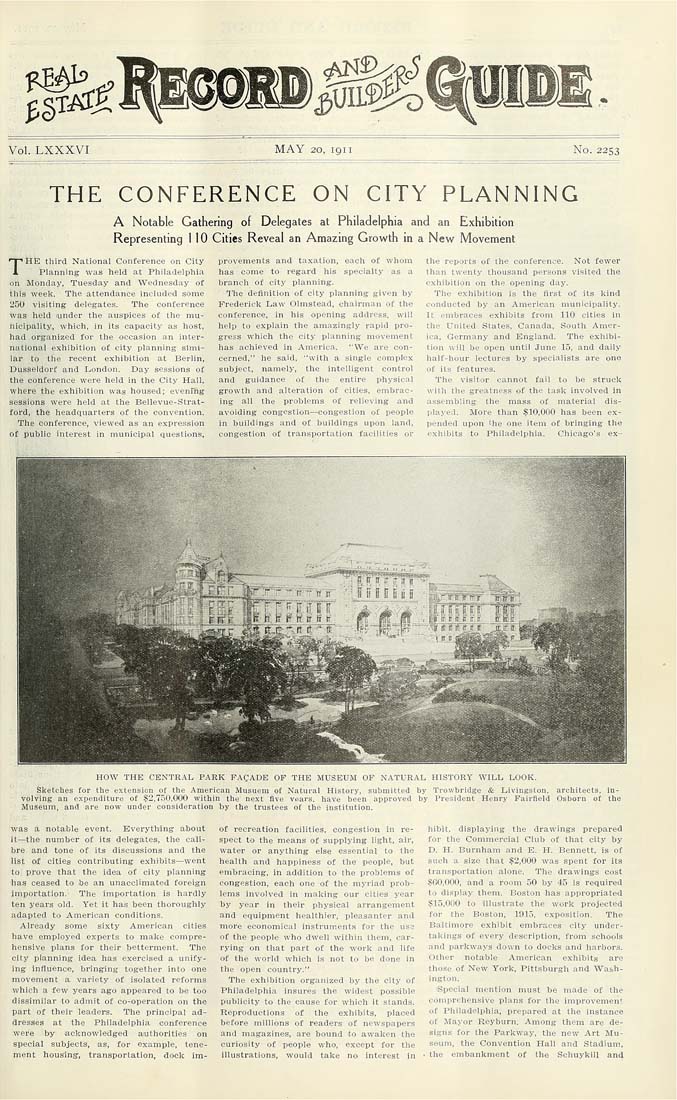Please note: this text may be incomplete. For more information about this OCR, view
About OCR text.
Vol. LXXXVI
MAY 20, 1911
No. 2253
THE CONFERENCE ON CITY PLANNING
A Notable Gathering of Delegates at Philadelphia and an Exhibition
Representing 110 Cities Reveal an Amazing Growth in a New Movement
THE third National Conference on City
Planning was held at Philadelpliia
on Monday, Tuesday and Wednesday of
this week. The attendance inclucied some
250 visiting' delegates. The conference
was hold 'Under the auspices of the mu¬
nicipality, which, in its capacity as host,
had organized for the occasion an inter¬
national exhibition of city planning simi¬
lar to the recent exhihition at Berlin,
Dusseldorf and London. Day sessions of
the conference were held in the City Hall,
where the exhibition wag housed; evennig
sessions were held at the Bellevue-Strat-
ford, the headquarters of the convention.
The conference, viewed as an expression
of puhlic interest in municipal questions.
provements and taxation, each of whom
has come to regard his specialty as a
branch of city planning.
T'he definition of c'ty planning given by
Frederick Law Olmstead, chairman of the
conference, in his opening address, will
help to explain the amazingly rapid pro¬
gress which the city planning movement
has achieved in America. "We are con¬
cerned," he said, "with a single complex
subject, namely, the intelligent control
and guidance o£ the entire physical
growth and alteration of cities, embrac¬
ing all the problems of relieving and
avoiding congestion—congestion of people
in buildings and of buildings upon land,
congestion ol tra.nsportation facilities or
the reports of the conference. Not fewer
than twenty thousand persons visited the
exhibition on the opening day.
The exhibition is the first oC its kind
conducted by an American municipality.
It embraces exhibits from 110 cities in
the United States, Canada, South Amer¬
ica, Germany and England. The exhibi¬
tion will be open until June 15, and daily
half-hour lectures by specialists are one
of its features.
The visitor cannot fail to be struck
with the greatness of the task involved in
aiisembling the mass of material dis¬
played. More than $10,000 has been ex¬
pended upon the one item of bringing the
exhibits to Philadelphia. Chicago's ex-
HOVi' THE CENTRAL PARK FACADE OF THE MUSEUM OF NATURAL HISTORY 'WILL LOOK.
Sketches for the extension of the American Musuem of Natural History, submitted by Trowbridge Se Livingston, architects, in¬
volving an expenditure of $^,750,000 within the next Sve VGars, have been approved by President Henry Fairfield Osborn of the
Museum, and are now under consideration by Lhe trustees of the institution.
'was a nota^ble event. Everything about
it—the number of its delegates, the cali¬
bre and tone of its discussions and the
list of cities contributing exhibits—went
to. prove that the idea of city planning
■haa ceased to toe an unaccUmated foreign
importation. The importation is hardly
ten years old. Yet it has been thoroughly
adapted to American conditions.
Already some sixty American cities
have employed experts to make compre¬
hensive plans for their betterment. The
city planning idea has exercised a unify¬
ing influence, bringing together into one
movement a variety of isolated reforms
which a few years ago appeared to bo too
dissimilar fo admit of co-operation on the
part of their leaders. The principal ad¬
dresses at the Philadelphia conference
were by acknowledged authorities on
special subjects, as, for example, tene¬
ment housing, transportation, dock im-
of recreation facilities, congestion in re¬
spect to the means of supplying light, air,
water or anything else essential to the
health and happiness of the 'people, IJut
embracing, in addition to the problems of
congestion, each one of the myriad prob¬
lems involved in making our cities year
by year in their physical arrangement
and equipment healthier, pleasanter and
more economical instruments for the use
■of the people who dwell within them, car¬
rying on that part of the work and life
of the world which is not to be done in
the open country."
The exhibition organized by the city of
Philadelphia insures the widest possible
publicity to the cause for which it stands.
Reproductions of the exhibits, placed
before millions of readers of newspapers
and magazines, are bound to awaken the
curiosity of people who, except for the
illustrations, would take no interest in
hibit. displaying the drawings prepared
for the Commercial Club of that city by
D. H. Burnham and E. H. Bennett, is of
such a size that $2,000 was spent for its
transportation alone. The drawings cost
.^fiO.OOO, and a room 50 by 45 is required
to display them. Boston has appropriated
$15,000 to 'illustrate the work projected
for the Bosion, 1915, exposition. The
Baltimore exhibit embraces city under¬
takings of every description, from schools
and parkways down to docks and harbors.
Other notable American exhibits are
those of New York. Pittsburgh and Wash¬
ington.
iS.pecial mention must be made of the
comprehensive plans for the improvement
of Philadelphia, prepared at the instance
of Mayor Reyburn. Among them are de¬
signs for the Parkway, the new Art Mu-
seium, the Convention Hall and Stadium,
. the embankment of the Schuykill an^








